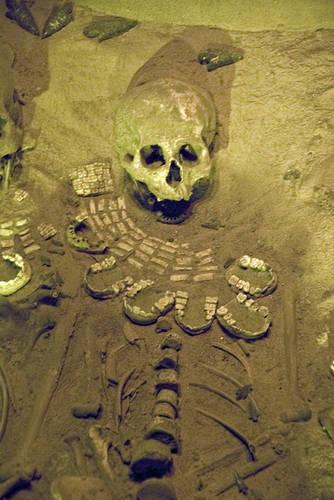The role of cosmetics in Teotihuacan funerary rites
Katy Meyers
Source - http://www.bonesdontlie.com/
If you’ve ever read Janet Evanovich’s Stephanie Plum novels, you know that makeup can play a very important role in funerals. In “Two for the Dough”, Grandma Mazur ranks funeral parlors based on a number of criteria, including their ability to properly do one’s makeup. “‘When I die you make sure I’m taken to Stiva’ Grandma Mazur said on the way over. ‘I don’t want that no talent Mosel laying me out. He don’t know nothing about makeup. He uses too much rouge’” (Evanovich 1999:34). The use of coloring and makeup in funeral rites and burials is not unknown in the past either. Red or yellow ochre was often used to paint the bodies of the deceased in various regions during the Neolithic period. Egyptians had containers and palettes for makeup in their tombs, and their eyelids were often decorated after death.
A new article from the Journal of Archaeological Sciences by Domenech-Carbo et al. 2012, analyzes the chemical composition of samples of cosmetic materials from Teotihaucan in order to assess their function in funerary rites. Teotihaucan is an archaeological site in Central Mexico that dates from 100-600 CE. It was an urban center surrounded by smaller communities. The society was hierarchical, with a number of levels of status. The mortuary program at Teotihaucan varies by status, with low status individuals buried in floors or public areas within earthen pits, and high status individuals receiving deeper burial pits in more public and sacred spaces. The grave goods found with individuals also vary by status ranging from ceramic vessels and obsidian to jadeite and highly decorated vessels. Elite burials are found in tombs with exotic materials and metals.
31 miniature vessels were recovered from a burial dating to 200-350 CE. The materials found within were thought to be some type of pigmentation. A multi-technique approach was taken to understand their composition, including light microscopy, scanning electron microscope, x-ray diffraction, and a number of types of spectrometry. These provided the researchers with information on the chemical, mineral and elemental composition. The vessels contained a variety of types of pigment. These include a spectrum of colors from pale yellow to brown-orange to dark reds to black. Minerals found include barite, cinnabar, mica, galena, jarosite, quartz, zircon and others. Of these materials, 3 vessels contained minerals that were not found in the Teotihaucan region and had to of been imported from elsewhere: galena, jarosite and mica. Based on composition, these would have served well as makeup since toxicity was minimal.

Teotihuacán Warrior, via About Archaeology
Domenech-Carbo et al. 2012 argue that the recovery of these materials from a burial site suggests that they were either used in the funeral rites or were an offering to the deceased as representative of their profession. The burial is considered to be among the elite, perhaps warriors or dancers. Therefore the makeup may be for them to take into the afterlife as war makeup or stage makeup. However, it is highly possible that this use relates more to the funerary rites. Domenech-Carbo et al. 2012 note that is was a common practice in Mesoamerica to decorate the bodies of the elite with cosmetics as part of the funeral. They conclude that they don’t have any clear answers as to the function of these cosmetics, but that this find is important because it is the first evidence of cosmetics in this period of history in Mesoamerica.
What I consider to be the most important conclusion of this paper is the elaboration of funeral rituals. When we assess status it is often done by the materials they are found with or the perceived effort that went into burial. This often ignores the importance of the process of the funeral leading up to the burial. Burials are often the final step, in assessing the variable cost we need to look at the entire mortuary process. If this find is indeed makeup used for a funeral ritual, it means that there was a certain amount of effort put into the body prior to its burial. If burials are compared by the presence of makeup, we may see a change in the way that status is viewed in this period. What needs to occur now is to have a comparison of burials from this area to determine if there are any other makeup vessels which could determine whether this represents ritual or occupation. Looking at inscriptions may also be revealing on the topic. Regardless, it is interesting and valuable to see a study that focuses on the funeral process rather than just on the burial itself.
Works Cited
Doménech-Carbó, M., Vázquez de Agredos-Pascual, M., Osete-Cortina, L., Doménech-Carbó, A., Guasch-Ferré, N., Manzanilla, L., & Vidal-Lorenzo, C. (2012). Characterization of prehispanic cosmetics found in a burial of the ancient city of Teotihuacan (Mexico) Journal of Archaeological Science, 39 (4), 1043-1062 DOI: 10.1016/j.jas.2011.12.001
Evanovich, J. 1999. Two for the Dough. St. Martin’s Griffin Press.